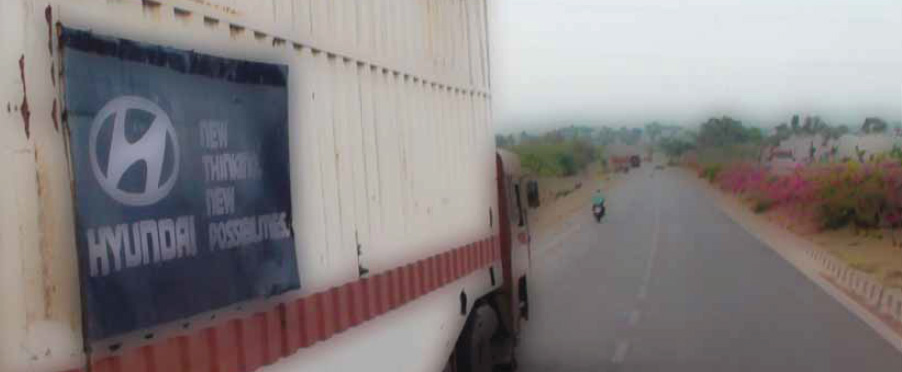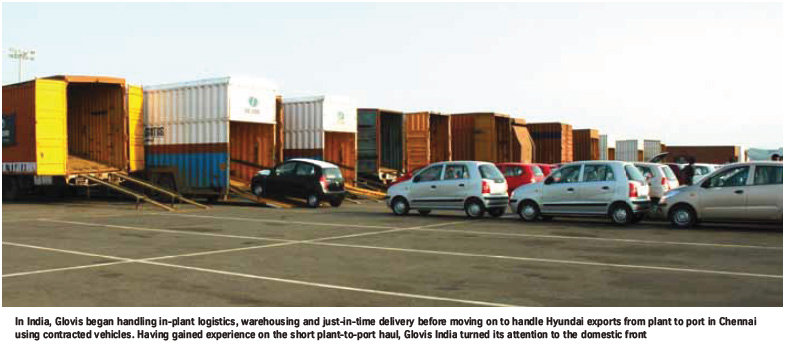
Glovis India has grown tremendously since it entered India, including its recent entry into owning a fleet of car carriers. Ramesh Kumar discovers that the company aims to crack the top ten set of logistics providers by 2015.
Sometimes, you don’t have to be the number one to set the pace. Hyundai Motors India is the country’s second largest passenger carmaker but it is out in front in terms of the vehicle logistics segment through its fully-owned subsidiary, Glovis India. Launched in 2006, Glovis India owns ten car carriers, each 22 metres long. Like Maruti Suzuki, India’s top carmaker in the passenger car segment, Hyundai was totally dependent on external car carriers until November 2010. That is no longer the case.
“India is a market you can ignore only at your peril,” says 54-year old Min Joo, managing director of Glovis India, who has spent his entire career within the precincts of the South Korean automotive giant at home and now abroad. His dream is to position Glovis India in the top ten bracket of global logistics and trading providers in the country by 2015, from 20th place today. “Nothing is impossible if you’re confident,” says Joo.
“We have been able to make a breakthrough as an established 3PL player in this market,” interjects Sajith Sivan, Glovis India’s general manager, who has overseen the car carrier business from its inception.
Glovis came into existence in 2001 to manage the logistics responsibility of its parent, Hyundai, following the decision to segregate various areas such as spare parts, IT, manufacturing and logistics. Similar to Gefco within PSA Peugeot-Citroën, Glovis is more-or-less present wherever Hyundai is.
 In India, Glovis began without much fanfare, handling in-plant logistics, warehousing and just-in-time delivery. Soon after its establishment, Glovis began handling Hyundai exports to the port of Chennai using contracted vehicles. Having gained experience on the short plant-to-port haul, Sivan and his team turned their attention to the domestic front with spectacular results. The car carrier business commenced last year with the order of 22-metre transporters even as rival Maruti Suzuki was going for 18.75-metre ones. From 152,000 cars in 2008, today Glovis India is handling around 386,000 annually.
In India, Glovis began without much fanfare, handling in-plant logistics, warehousing and just-in-time delivery. Soon after its establishment, Glovis began handling Hyundai exports to the port of Chennai using contracted vehicles. Having gained experience on the short plant-to-port haul, Sivan and his team turned their attention to the domestic front with spectacular results. The car carrier business commenced last year with the order of 22-metre transporters even as rival Maruti Suzuki was going for 18.75-metre ones. From 152,000 cars in 2008, today Glovis India is handling around 386,000 annually.
“There was a lot of scepticism when I came on board,” recalls Sivan, the first Glovis India employee. From small beginnings, Sivan now pushes 1,600 passenger cars per day into the domestic market and more than 600 vehicles for export. His handling capacity could actually reach 3,000 vehicles a day but there is congestion at Chennai port.
Of late, Sivan has won over Mahindra Logistics–which also has its own fleet and a captive parent in the form of Mahindra & Mahindra (M&M)–to service the south-towestern corridor. Hyundai’s fleet moving to Mumbai and Pune returns with M&M vehicles for the southern market. Glovis India has also begun bidding seriously with carmakers in the fast-growing western hub of Sanad in Gujarat. Tata and GM are established there, and Ford and PSA are also building factories.
“We have the experience, network and strength. Why not collaborate and achieve optimum fleet utilisation? It’s a winwin situation for everyone,” explains Sivan. He was even ready to bid for Maruti Suzuki’s Bengaluru Transport Park, but did not on competition grounds. “Hyundai has a stockyard there and therefore we have experience. But we were not allowed to bid,” he adds.
Dreams of being in the top ten
Glovis India bought its car carriers to gain first-hand knowledge of the segment. According to Sivan, Indian carmakers can afford to manage around 80-125 car carriers but beyond that the threshold it is unmanageable. He rules out consolidation because most car carriers are heavily involved in cash transactions and hence become “ineligible for proper due diligence” for potential buyers. Sivan does not want to buy out any existing car carrier business but prefers “organic growth”. He plans to add 20 per quarter next financial year.
Servicing the parent company is one thing but growing the business to realise the 2015 dream compels Glovis India to look beyond Hyundai. That is where Ramana Adivishnu, chief operating officer in charge of business development, comes in. This is the second stint at Hyundai Motors for the mechanical engineer who worked in production planning and exports between 1998 and 2001. This time he is tasked with expanding business beyond car carriers at Glovis India. One recent example is that the container freight station at Irungattukottai, just behind the Hyundai Motors assembly plant in Chennai, is now available to handle consignments for all. It clears containers from the port for Renault Nissan and Hyundai Motors’ vendors. While 90% of Glovis India revenue is from Hyundai, for the container services segment about 60% of revenue now comes from non-Hyundai clientele, according to Ramana. Yet it has been tough terrain in winning over the confidence of customers, particularly for the distribution of vehicles, given that Glovis India is a fully owned Hyundai Motors subsidiary.
“There is still resistance,” admits Ramana. “Hyundai Motors is a customer, like anyone else. No special consideration is given to them. Luckily for us, the horizontal movement of staff from Hyundai to other OEMs has also helped others to understand the DNA of Glovis India.” But aside from the Mahindra movements, other carmakers are served, including Renault Nissan, which often uses Glovis vehicles at critical points.
A long-term business plan
Min Joo’s business plan is impressive. It is specialised in providing a one-stop-shop logistics service including transport, warehousing, stevedoring and reverse logistics to its customers. Expansion is very much on the cards. “Our aim is to become the best SCM partner for domestic as well as global logistics,” he adds. Broadly speaking, Glovis India’s services include total car carrier transport, in-plant logistics, container freight, freight forwarding, warehousing, logistics consulting and complete knockdown (CKD) services. At present, CKD business is done only for Hyundai, whose parts are exported to overseas clients. “CKD export is a niche area and there is no experience,” points out Ramana. Quality assurance and packaging are critical and Min Joo has taken special care in getting Korean experts to train local staff.
Merchandising is a new focus area for Glovis India. Like its Korean and Japanese trading counterparts, Glovis India is serious about buying and selling material from overseas for sale in India. The transport of Australian coal for the Indian market is already happening. Steel, reusuable plastics and iron ore are all potential products, particularly for the automotive industry. Jonghoon Choi, chief operating officer of Glovis India, maintains that he would like to bring down the share of Hyundai Motors business to 40% by growing with other customers. “Pune is where we would be looking at as our next hub,” he says.
Gaining the confidence of Mahindra Logistics in the western corridor is a big incentive for Glovis India to push hard. Though the domestic automotive market has hit a snag recently, this does not worry the team. The future is bright, they assert. Growing their kitty from Rs.1,300 crore ($250m) to greater heights, they are confident, should not be a problem as India continues to grow.

























![Global[1]](https://d3n5uof8vony13.cloudfront.net/Pictures/web/a/d/s/global1_726550.svgz)









